Tue May 10th, 2016 5:44am, NYC
EXPERIENCE:
NY Gurubai’s Visit to Japan, Winter 2016
and Its Synchronization with Pranavadipa Vol. 17 & Vol. 18:
Part 7:
The Meaning of ‘Practicing In Real Life’ With a Concrete Aim,
and Its Application in Discrimination
Day 9: Morning & Afternoon
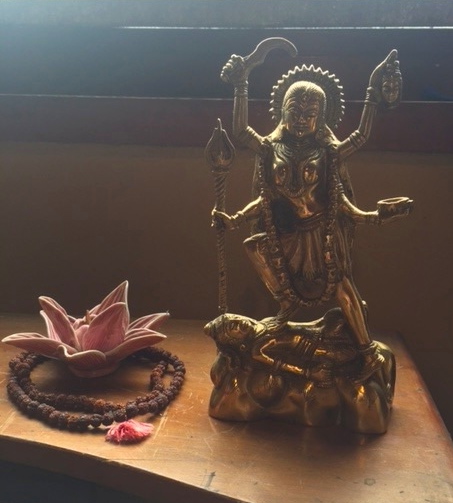 Kali at Satya’s altar in Yoga Vihara
Kali at Satya’s altar in Yoga Vihara
On Saturday morning, Aniruddha came to Yoga Vihara to investigate a loud noise he had heard that sounded like some animals running around. Sometimes this happens somewhere in the area between the ceiling of the ground floor and the floor above, and they have been having this issue for quite a while, which is especially common in old houses in Kyoto. Aniruddha is a professional, well-experienced exterminator who uses only natural pest-control products, and after studying the problem, he concluded that there were no rats there but most likely it was a weasel. Yogadanda and Satya, who live at Yoga Vihara, figured that a weasel wasn’t harmful, and so they decided to leave it be.
We had a full day scheduled that day: Asana and Meditation class in the afternoon and Satsangha at night. In order to stay on schedule, Satya prepared an early light lunch. Anandi, who stayed over the night before, was also present.
Now that there were only a few days left in Kyoto before they returned to New York, Aniruddha started thinking more seriously about how he would integrate some of the key lessons he was learning into his regular practice when he got home. The conversation naturally turned to diet, an area in which he was open to any possible improvements.
He does not cook often but he would like to improve his dietary habits. He said that the problem was that due to the fact that his job is very irregular, he finds himself unable to maintain a regular schedule for eating lunch and dinner. His schedule changes from day to day depending on his clients, the locations and the time. He treats several apartments per day, so he travels from one place to another by car, but the situation is such that he often finds himself in areas where he cannot get a decent, vegetable-based meal, so he ends up grabbing something quick rather than eating a real lunch at the proper time. Hearing that, the Kyoto gurubhai responded that he should bring his lunch box with him, because in this way he can have lunch whenever he is able to and he won’t need to look for a place to get a decent meal. Inside the lunch box could be sandwiches or pasta, or even a soup, or something left over from the night before. He could even plan to cook dinner with an extra portion for lunch the next day. Aniruddha responded that he did not bring leftovers because he cannot warm up the food. He said, “I like my food hot.” That answer surprised everyone. Because it was not about his struggles in organizing his time or his schedule, nor was it about his skills or the content of the meal, but it related to his personal preference. Generally, if we are asked whether we would prefer to eat a meal hot or cold, almost everyone will answer that warm is preferable. But what we were discussing had nothing to do with these kinds of situations. If Aniruddha was seriously concerned about his dietary habits and really concerned about controlling the timing and content of his daily meals for the purpose of conditioning his asana and meditation practice, then any concerns about whether the food is warmed up or cold should not bother him.
(Satya, when she was asked by Aniruddha on Saturday night (Day 2) at Shanti Kutira when she came after the Satsangha how she managed to establish regular practice at the beginning, answered that since she moved into Yoga Vihara, where Yogadanda and two other disciples were living and practicing asana and meditation daily, she naturally followed that example, so it was not difficult at all.)
She witnessed for eight straight years how Yogadanda would manage to make time for his daily practice of asana and meditation by disciplining himself not to have dinner at all, but to have breakfast and lunch in greater amounts in order to sustain the physical body, which, after all, is simply a vessel for Realization. In Yogadanda’s case, he had the clear goal of realizing the Truth, so he made his decisions based on that:
I want to realize the Truth. → For that, to deepen the practice is a must. → For that, the practice of asana and meditation is indispensable. → For that, I need to practice them daily.
CONCLUSION: In order to sustain my daily practice of asana and meditation, I can’t eat dinner due to the schedule of my job.
Whether he was eating dinner or not, was not of concern.
(Note: Mr. Shimada skips lunch and practices asana at lunchtime at his job for the same reason.)
By clarifying and making one’s goal concrete, one’s action can change naturally. If one determines to practice of asana and meditation daily, it is natural to plan one’s daily schedule accordingly, including the practice of dietary habits. When she heard Aniruddha’s answer, she thought that his action was not based on having a firm or clear and concrete goal, but rather it was all left up to random choice. If the goal is vague, no matter how we try to suggest some ideas, it does not serve much purpose. So then she said to him that if having a hot meal is what he wants, then that is ok; he can think about how to get that. She then asked him, “But what do you want really?”
 Yogadanda’s lunch box prepared by Satya
Yogadanda’s lunch box prepared by Satya
*
(Note: Yogadanda practiced asana for about 10 years, up until the point when Shri Mahayogi told him to stop. Once he had a high fever from a bad cold and, remembering that Shri Mahayogi had said that asana practice is ineffective when one is at the peak of a bad cold, he decided to see for himself by doing halasana. In so doing he discovered that it is true—all it did was make him nauseous. Out of those 10 years, that was the only day that he did not practice asana that he can recall. He says that even if there were days when he he did not practice and cannot remember having not practiced, the number of days would surely be fewer than five.)
*
POSTSCRIPT: To conclude the conversation
Satya contributed the following thoughts based on her experiences from her practice:
The aim can be realizing the Truth, uniting with God—although it is necessary to think with much more seriousness and in much more realistic terms, and that might relate to timing (for the real serious yearning might be different to different people.) However, it is truly easier to grasp your ideal and put it into action if you have a more concrete, detailed idea of what you are aiming for. Then it can be broken down and measured against our daily actions. For example, it can be as simple as the “discipline to practice asana and meditation daily.” Or if you are seriously concerned about dietary habits, the discipline to cook at home daily and stop eating out. It is natural that these concrete aims can vary according to one’s specific life situation. Whatever your choice might be, if you think about how you spend your day for the purpose of reaching your ultimate goal, you realize that there are actually many situations and points at which you must make choices one by one. For instance, let’s say that someone gives you a snack or a sweet, you can make the choice of declining it or having it later. Let’s say that you determined to cook at home every day and not eat out or order take-out. You are invited by someone to have a meal, or you see or find foods that you are drawn to or curious about and you want to buy them… At that very moment, recalling your concrete goal, and then making your choice based on that, is the actual first step of the practice of discrimination.
Through repetition, making such choices in your daily life clarifies your goal more and more. Consequently, the shaft of light that is Yoga or Truth (your faith in Yoga) grows and eventually matures. At the same time, you will gain self-confidence. When that shaft of light gets stabilized and becomes firm, then you will be able to discriminate when disturbances arise in your mind.
You might not have given much thought to these matters, and I do not know how you have practiced up until now, but if you really want to be able to discriminate as you said, I would suggest that you repeatedly practice discrimination using these daily situations, events and interactions as opportunities for practice. Then you will be able to apply discrimination when you face bigger issues more smoothly.
*
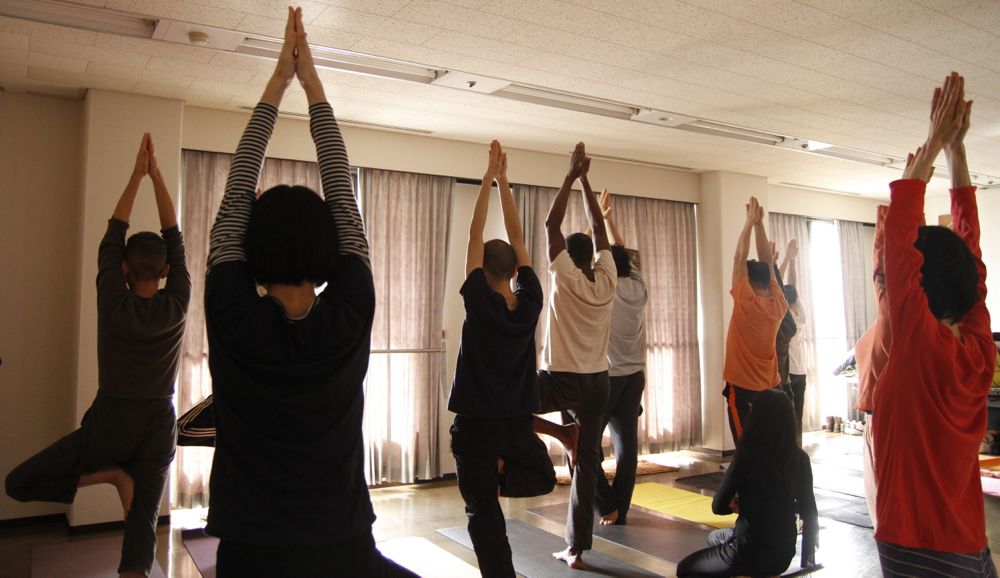
From 2PM, there was an Asana and Meditation class led by Shantimayi and Dharmini. This weekend was the special weekend that the monthly Satsangha with Shri Mahayogi at the Ashrama would be taking place, as well as Siddha Marga the next day, so there were many disciples who had travelled from Tokyo, Matsuyama and other areas. The class was packed, and filled with a condensed energy by everyone in attendance. Shantimayi checked everyone’s asana very precisely. It was a wonderfully energetic class.

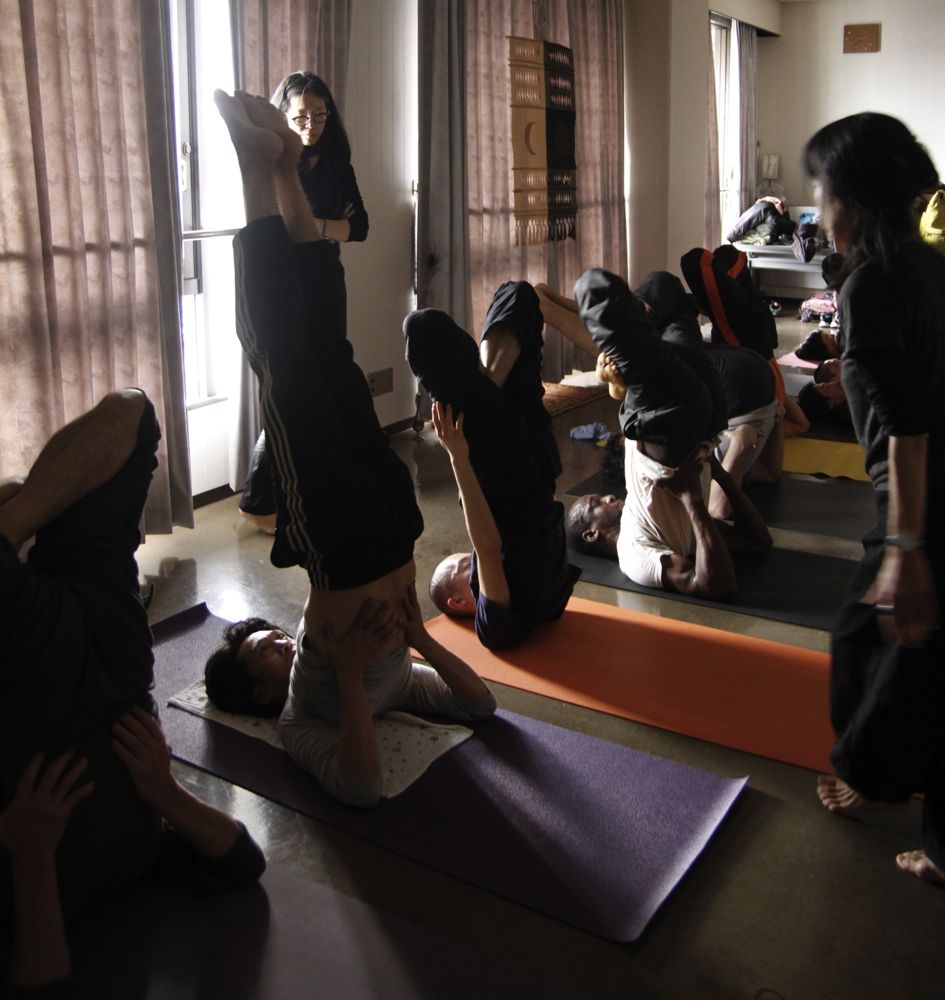
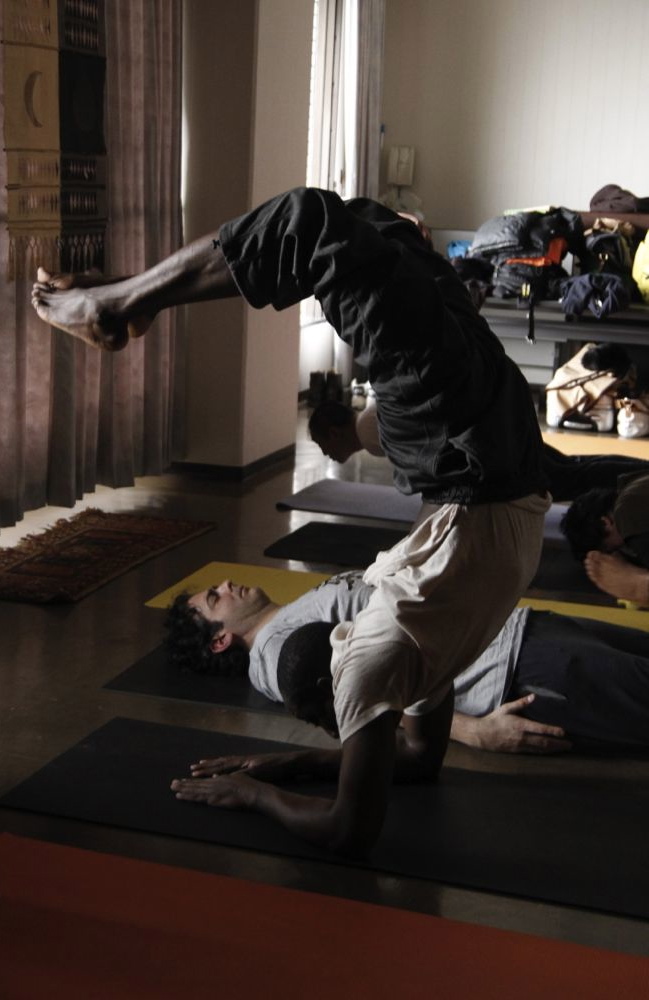
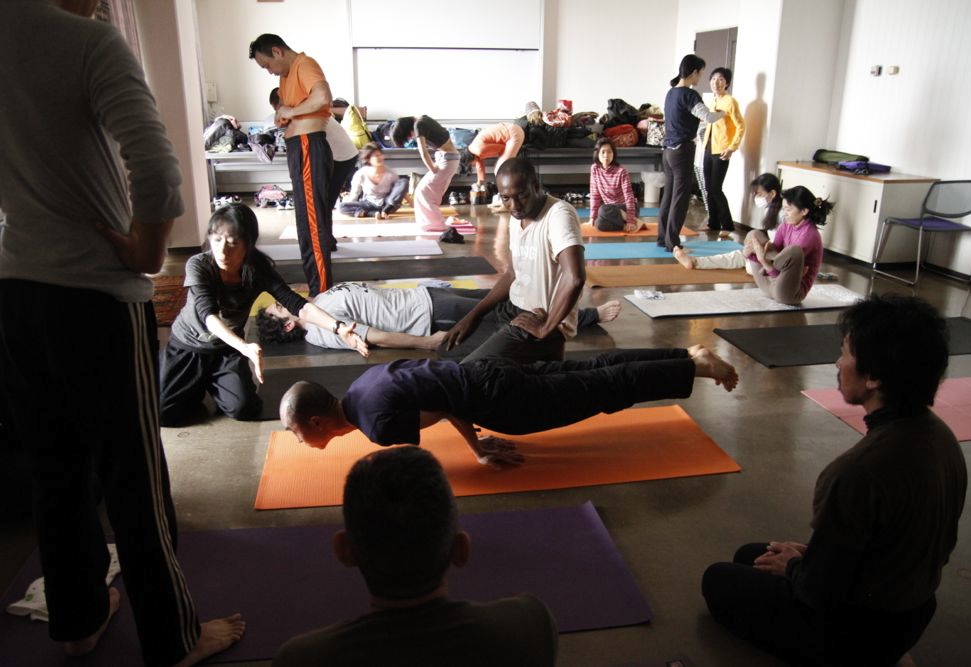
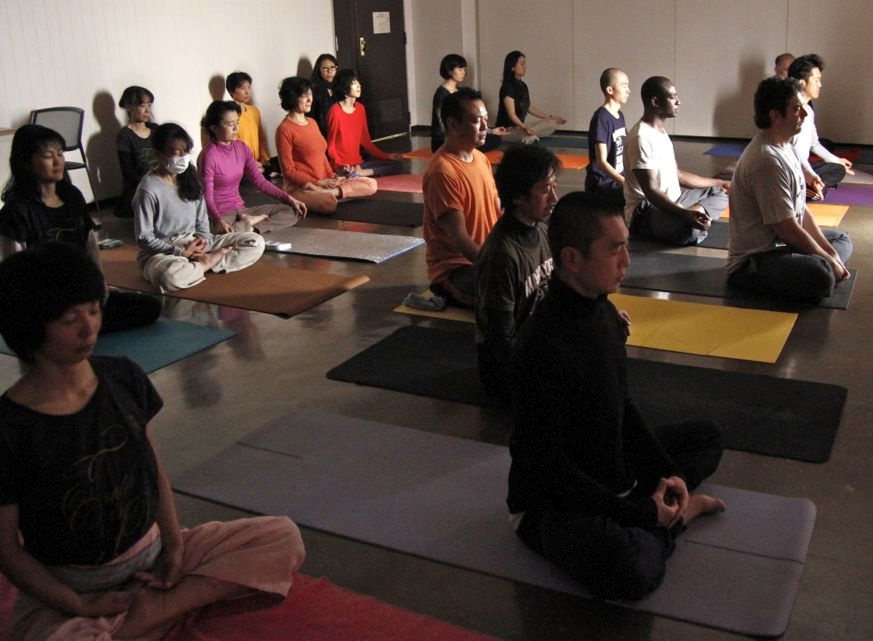
In the end, Shantimayi said that Yoga is not only the practice of asana, and that she has been taught that actually disciplining herself in the practice of yama (abstinence) and niyama (observance) in daily life, and making the corresponding actions with her body (action), mouth (word) and mind (thought) are the most important practices. She said that the result of your practice of aligning action-word-thought in daily life manifests in asana practice. And that she understood by her practice that unless you establish the harmony of ‘action, word and thought’ the completion of advanced asana would not be achieved. She added that if one acquires a good foundation in basic asana practice, it will surely lead to meditation, and therefore establishing that base is very important.
Shantimayi asked the NY brothers about their impression of this class. Nandi started to speak, and he said that rather than speaking about this class he would like to express his gratitude for this entire trip to everyone. He said that this trip was quite challenging because he had to come face to face with his own issues, but he was so grateful to have had this opportunity and he felt so determined to continue to work on himself and deepen his practice. Ryan said that he was amazed that they could see in him more than what he could see in himself, and he was so grateful for everyone’s hospitality and support. Aniruddha said that it was a life-changing experience, and that he never lived his life with the ultimate goal at the center, but now he understands the purpose of living, and that his view toward asana practice has changed as a result. He also expressed his gratitude.
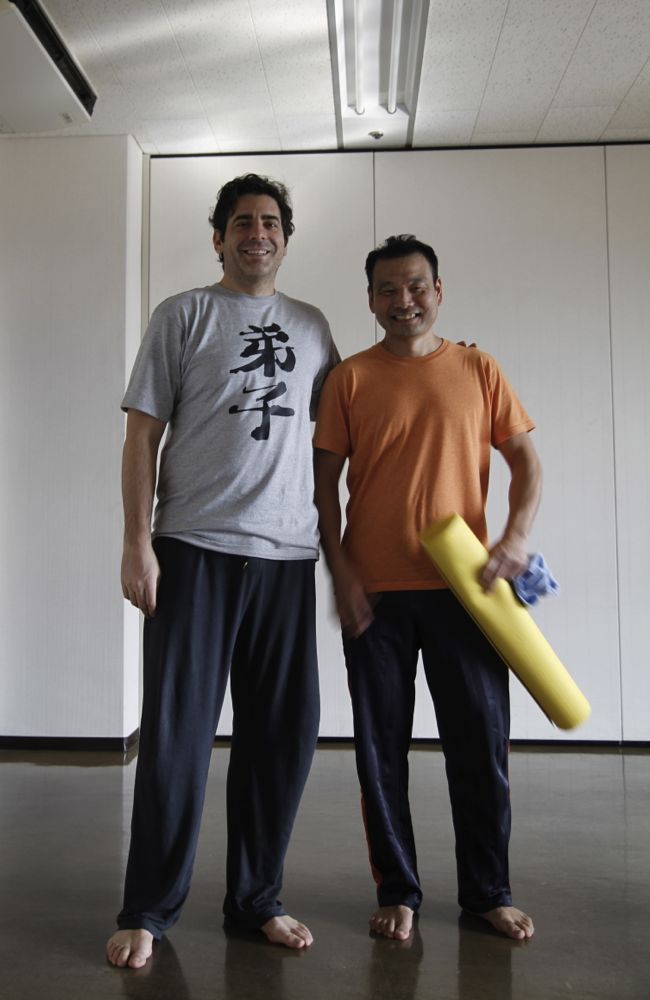 Ryan (弟子 on his T-shirt ‘disciple’) and Asanghan
Ryan (弟子 on his T-shirt ‘disciple’) and Asanghan
*
After the class, Taka and Aniruddha went to Ganesha (the residence of Kinkara, where many meetings take place) to speak with Asanghan, who had travelled from Matsuyama, and ask if he could come to Yoga Vihara after the Satsangha that night. Asanghan was in the middle of a work meeting with Sananda and all the gurubhai from Matsuyama, but he came outside the house to speak with them. At first, Asanghan hesitated to accept the request because he had a prior engagement, but their persistence persuaded him to change his schedule.
(The day continues… )
*
Pranavadipa 18 is up and the topics in the Satsangha are in synchronization with these conversations! Please read, reflect upon them carefully, and turn them into action!
*****
Pranavadipa is a Monthly Publication of Online Study Material containing the Teachings of Satguru Shri Mahayogi Paramahansa & the Experiences of Practitioners that is available by annual subscription. A new volume of Pranavadipa is issued on the 8th of every month.

